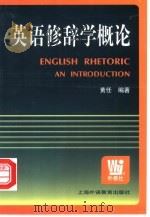《英语是同修辞学 RHETORIC IN PRACTICE》
| 作者 | 编者 |
|---|---|
| 出版 | 宏图图书公司 |
| 参考页数 | 270 |
| 出版时间 | 没有确切时间的资料 目录预览 |
| ISBN号 | 无 — 求助条款 |
| PDF编号 | 816372938(仅供预览,未存储实际文件) |
| 求助格式 | 扫描PDF(若分多册发行,每次仅能受理1册) |

Ⅰ.THE BACKGROUND AND FIELD OF RHETORIC1
Historical Background of Rhetoric1
What Rhetoric Treats about To-day3
Rhetoric as a Practical Study4
Ⅱ.RHETORIC AS PRACTICED WITH WORDS6
General Discussion6
Ⅰ.Kind of Words to Choose7
(A)Choosing Words According to Nature7
1.Words for Clearness7
(1)Simple Words7
Exercises8
(2)Specific Words8
Exercises10
(3)Denotative Words10
Exercises11
2.Words for Accuracy12
(1)Words of Right Shade of Meaning12
Examples13
(2)Words of Right Degree of Meaning14
Examples14
(3)Words of Right Kind of Meaning15
Examples15
Exercises16
3.Words for Effectiveness17
Words for Connotation18
(a)Idiomatic Words18
(b)Descriptive Words19
(c)Figurative Words22
(1)Similes24
(2)Metaphors25
(3) Metonymy26
(4)Personification26
Exercises28
(B)Choosing Words According to Use29
Words in Good Use30
(a)Present Words30
(b)Reputable Words32
(c)National Words33
Exercises35
Ⅱ.Kind of Words to Avoid35
(A)Words to Avoid for Practical Utility36
1.Foreign Words not Naturalized36
2.Obsolete Words37
3.Newly-Coined Words37
4.Technical Words38
(B)Words to Avoid for Good Taste39
1.Colloquialisms39
2.Provincialisms41
3.Vulgarisms42
Exercises43
Ⅲ.RHETORIC AS PRACTICED WITH SENTENCES44
General Discussion44
Grammatical andRhetorical Classification of Sentences44
The Structure of Sentences45
1.Simple Form46
2.Modified and Enlarged Form46
Pleonastic Sentence Structure47
Elliptical Sentence Structure47
The Uses of Sentences48
(1)The Use of Simple Sentence48
(2)The Use of Compound Sentence48
(3)The Use of Complex Sentence48
(4)The Use of Compound-Complex Sentence49
(5)The Use of Periodic Sentence49
(6)The Use of Loose Sentence49
(7)The Use of Balanced Sentence50
The Essential Qualities of Sentences50
1.Sentence Clearness51
Ⅰ.Correct Diction51
(a)Position of Adverbs51
(b)Position of Modifiers in General.52
(c)Use of Pronouns52
(d)Watch for Squinting Construction.52
Ⅱ.Proper Punctuation53
(a)Placing of Period53
(b)Insertion of Comma and Semicolon53
(c)Use of Interrogation Point53
2.Sentence Unity54
How to Preserve Sentence Unity54
(a)First Determine Central Thought54
(b)Use Additional Clause for Explanation54
(c)Group Clauses with Semicolons54
Precautions Concerning Sentence Unity56
Precaution 1.Change of Subject56
Precaution 2.Separation of Ideas57
Precaution 3.Crowding Details57
Precaution 4.LooseArrangement of Relative Clauses58
Ways for Telling Sentence Unity58
1.By Total Impression58
2.By Proper Relation of Clauses59
Exercises for Sentence Unity60
3.Sentence Coherence61
What Sentence Coherence Is61
Ⅰ.Promotion of Sentence Coherence62
(a)Natural Order of Words62
(b)Logical Use of Negatives63
(c)Logical Connections and Relationships64
Ⅱ.Violation of Sentence Coherence64
(a)Needless Change of Construction65
(b)Relation between Participle and Noun or Pronoun65
(c)Relation between Pronoun and Antecedent66
Exercises for Sentence Coherence67
4.Sentence Emphasis67
What Sentence Emphasis Is67
How to Secure it68
Ⅰ.By Position68
(a)Beginning and End of Sentence68
(b)Order of Climax69
(c)Inverted Word Order69
Ⅱ.By Word Manipulation69
(a)Word Repetition70
(b)Word Antithesis70
(c)Omission of Uniniportant Words70
Emphatic Sentences70
(1)Short Sentence71
(2)Periodic Sentence71
(3)Balanced Sentence71
Exercises for Sentence Emphasis72
5.Sentence Euphony73
What Sentence Euphony Is73
Ⅰ.Promotion of Sentence Euphony73
(a)By a Natural Beginning73
(b)By Easy Movement74
(c)By Cadence at the End74
Ⅱ.Violation of Sentence Euphony75
(a)From Needless Repetition75
(b)From Harsh Combinations75
(c)From Metrical Structure76
(d)From Frequent Alliteration76
Exercises for Sentence Euphony77
6.Sentence Strength77
What Sentence Strength Is77
How to Secure It78
(1)Careful Use of Connective Words78
(2)Similar Construction of Contrasted Members78
(3)Liberal Use of Particular Terms79
Exercises for Sentence Strength79
Idiomatic Sentences Needing Special Attention80
Ⅳ.RHETORIC AS PRACTICED WITH PARAGRAPHS82
General Discussion82
Paragraph-Thought82
What a Paragraph Is83
The Topic of the Paragraph84
Paragraph as an Organic Structure85
Paragraph Plan85
Paragraph Analyzed86
Means of Paragraph Development88
1.By Definition88
Example Analyzed89
2.By Particulars and Details89
Examples Analyzed90
3.By Comparison and Illustration91
Example Analyzed91
4.By Specific Instances or Examples92
Example Analyzed92
5.By Presenting Reasons93
Examples Analyzed93
6.By Applying a Principle95
Example Analyzed95
7.By Stating Causes and Effects96
Examples Analyzed96
8.By Introductory and Summarizing Sentences98
(a)The Introductory Sentence98
Example Analyzed99
(b)The Transitional Sentence99
Example Analyzed99
(c)The Summarizing Sentence100
Example Analyzed100
General Laws Governing Paragraphs101
1.Paragraph Unity101
Examples Analyzed102
2.Paragraph Selection104
Examples Analyzed105
3.Paragraph Coherence107
(a)The Proper Arrangement of Sentences107
Example Analyzed108
(b)The Use of Proper Connecting Words109
Example Analyzed109
4.Paragraph Proportion110
(a)Sufficient Details to Show Purpose111
Example111
(b)Adequate Amplification111
Example112
(c)Ordinary Illustration for Simple Statement112
Example113
5.Paragraph Emphasis113
(a)By Repetition113
Example113
(b) By Space114
Example114
(c)By Contrast115
Example115
(d)By Position116
Example116
6.Paragraph Variety116
What Paragraph Variety Is116
Variety Secured by Diversity of Sentences117
Example Analyzed117
Types of Paragraph Structure118
General Discussion118
Kinds of Paragraph Structure119
Ⅰ.Expository and Argumentative Paragraphs120
(a) Logical Methods120
1.Inductive Method120
Example Analyzed121
2.Deductive Method121
Example Analyzed122
Two Methods Compared123
(b)Less Formal Methods123
1.ParagraphDevelopedThrough Definition123
Example Analyzed123
2.Paragraph DevelopedThrough Specific Instances124
Example Analyzed124
3.Paragraph Developed Through Causes and Results125
Example Analyzed125
Ⅱ.Descriptive and Narrative Paragraphs125
1.By Giving Incident126
Example Analyzed126
2.By Character Sketches127
Example Analyzed127
3.By Descriptive Sketches129
Example Analyzed129
Kinds of Paragraphs130
Ⅰ.The Isolated Paragraphs131
Example Analyzed131
Ⅱ.The Related Paragraphs132
1.Introductory Paragraph132
Example Analyzed132
2.Transitional Paragraph133
Example Analyzed133
3.Amplifying Paragraph133
Example Analyzed134
4.Concluding Paragraph135
Example Analyzed135
Exercises on Isolated Paragraphs136
Exercises on Related Paragraphs139
Written Exercises on Paragraphs154
Ⅴ.RHETORIC AS PRACTICED WITH WHOLE COMPOSITIONS156
General Discussion156
The Ways We Learn to Write Compositions156
Why Rhetoric Is Necessary in Composition157
General Rhetorical Principles of Relation158
1.The Principle of Distinction159
Example Analyzed159
2.The Principle of Sequence161
Example Analyzed161
3.The Principle of Climax161
Example Analyzed162
The Logical Order of Thought-Grouping163
1.The Defining Stage—Introduction163
2.The Developing Stage—Discussion164
3.The Applying Stage—Conclusion164
The Practical Plan of Composition165
(A)Concerning Introduction165
Examples Analyzed165
(B)Concerning Development or Amplification168
1.To Aid Memory—The Psychological Laws168
(a)The Law of Contiguity168
Example Analyzed169
(b)The Law of Similarity and Contrast170
Example Analyzed170
(c)The Law of Cause and Effect171
Example Analyzed171
2.To Give GoodMovement—Two Orders of Thought-Building172
(1)Inductive Order172
Example Analyzed173
(2)Deductive Order173
Example Analyzed174
(C) Concerning Conclusion175
1.Intellectual Type175
Example176
2.Emotional Type176
Example176
Classification of Compositions177
Ⅰ.Description177
Purpose of Description177
Example Analyzed178
Methods in Dcscription179
1.The Popular Method179
Example179
2.The Artistic Method180
Example180
3.The Scientific Method180
Example180
4.The Suggestive Method181
Example181
Points of View in Description182
1.The Fixed Point of View182
Example182
2.The Changeable Point of View183
Example Analyzed183
Selection of Details185
Examples185
Descriptive Compositions for Study185
Descriptive Compositions for Exercises190
Suggestions for Writing Descriptions190
Ⅱ.Narration191
Purpose of Narration191
Example Analyzed192
The Principal Elements in Narration192
1.The Plot192
2.The Setting193
3.The Character193
General Classification of Narratives194
Simple Narrative194
Example Analyzed194
The Requisites of Simple Narratives195
The Unity of Simple Narrative196
Example Analyzed196
The Sequence of Simple Narrative197
Example Analyzed197
The Climax of Simple Narrative198
Example Analyzed198
The Complex Narrative199
How to Change Simple Narrative into Complex Narrative199
The Obstacles, Physical and Mental201
Examples Analyzed201
The Suspense202
Example202
The Beginning of Narrative203
Example Analyzed203
The Climax of Narrative204
Example204
The Conclusion of Narrative204
Example204
Narratives for Study205
Narrative Compositions for Exercises207
Suggestions for Writing Narratives209
Ⅲ.Exposition211
Purpose of Exposition211
Example Analyzed212
Effective Exposition213
Process of Exposition—Analysis214
Example Analyzed214
Methods of Exposition215
1.Exposition by Narration or Description215
Example Analyzed215
2.Exposition by Paraphrase216
Example Analyzed217
3.Exposition by Abstract218
Example Analyzed218
4.Exposition by Definition—Intensive Exposition219
Logical Definition219
Example Analyzed219
Other Means of Logical Definition220
1.Exposition by Antithesis220
Example220
2.Exposition by Iteration221
Example221
3.Exposition by Analogy222
Example222
4.Exposition by Exemplification222
Example223
Expository Compositions for Study226
Expository Compositions for Criticism231
Subjects for Written Exercises233
Ⅳ.Argumentation234
Purpose of Argumentation234
Argumentation and Exposition234
Steps in Argumentation235
1.The Choice of the Subject235
2.The Wording of the Subject235
3.The Analysis of the Subject236
4.The Development of the Arguments236
5.The Conclusion236
Example Analyzed237
Two Forms of Argumentation239
(Ⅰ)Constructive Argumentation239
A.Through Direct Inquiry240
1.Personal Observation240
Example Analyzed240
2.Testimony241
Example Analyzed241
3.Authority242
Example242
B.ThroughReasoning—Induction243
1.Inference from Particulars243
Example Analyzed244
2.Particulars Viewed as Cause or Effect244
Example Analyzed244
3.Particulars as Circumstantial Evidence245
Example Analyzed246
4.Particulars as Example and Analogy247
Example Analyzed247
C.Through Reasoning—Deduction248
1.Syllogism in Literature249
Example Analyzed249
2.Syllogism in Enthymeme250
Example Analyzed250
3.Syllogism in Enlargement251
Example Analyzed251
(Ⅱ)Destructive Arg umentation252
Ⅰ.Analysis of Issues252
(a)By Reducing to Alternatives252
Example Analyzed253
(b)By Reductio ad Absurdum254
Example254
(c)By Dilemma255
Example Analyzed255
Ⅱ.Exposure of Fallacies256
(a)By Detailed Analysis256
Example256
(b)By Parity of Reasoning257
Example257
Argumentative Compositions for Study258
Argumentative Compositions for Exercise263
Suggestions for Writing Argumentative Compositions264
《英语是同修辞学 RHETORIC IN PRACTICE》由于是年代较久的资料都绝版了,几乎不可能购买到实物。如果大家为了学习确实需要,可向博主求助其电子版PDF文件(由 宏图图书公司 出版的版本) 。对合法合规的求助,我会当即受理并将下载地址发送给你。
高度相关资料
-

- 英语修辞
- 1988 北京:机械工业出版社
-

- 实用英语修辞学 (英文)
- 1985
-

- 英语修辞与写作
- 1996 上海:上海外语教育出版社
-

- 实用英语修辞学 英文
- 1985 南京:江苏人民出版社
-

- 俄语修辞学
- 1988 北京:外语教学与研究出版社
-

- 21世纪大学英语读写教程 第1册
- 1999 上海:复旦大学出版社;北京:高等教育出版社
-

- 英语修辞学概论
- 1999 上海:上海外语教育出版社
-

- 英语修辞大全
- 1995 北京:外语教学与研究出版社
-

- 英语修辞格词典
- 1992.11 重庆市:重庆大学出版社
-

- 英语修辞格
- 1983 北京:商务印书馆
-

- 英语修辞与写作
- 1991 青岛:青岛出版社
-

- 俗谚大全
- 1997 北京:大众文艺出版社
-

- 英语修辞赏析
- 1992 上海:上海交通大学出版社
提示:百度云已更名为百度网盘(百度盘),天翼云盘、微盘下载地址……暂未提供。➥ PDF文字可复制化或转WORD

